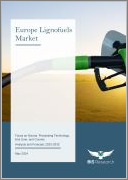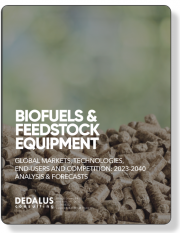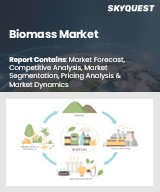
|
시장보고서
상품코드
1477895
유럽의 리그노 연료 시장 : 유래별, 가공 기술별, 최종사용자별, 국가별 : 분석 및 예측(2023-2032년)Europe Lignofuels Market: Focus on Source, Processing Technology, End User, and Country - Analysis and Forecast, 2023-2032 |
||||||
유럽 리그노 연료 시장 규모(영국 제외)는 2023년 8억 1,610만 달러에서 2032년 15억 920만 달러에 달할 것으로 예상되며, 예측 기간인 2023-2032년 CAGR은 7.07%에 달할 것으로 예상됩니다.
현재 진행 중인 연구 개발의 발전으로 리그노 연료의 생산 방법이 더욱 고도화되고 비용 효율성과 효율성이 향상되어 시장 개발을 촉진하고 있습니다. 핀란드의 Neste Porvoo Refinery와 같은 시설로 대표되는 통합 바이오 리파이너리에서 채택하고 있는 최첨단 기술은 바이오연료 생산을 위한 리그노셀룰로오스 기반 원료의 사용을 보여줍니다. 지원 정책과 인센티브는 리그노 연료 부문의 성장을 더욱 가속화하고 있습니다.
| 주요 시장 통계 | |
|---|---|
| 예측 기간 | 2023-2032년 |
| 2023년 평가 | 8억 1,610만 달러 |
| 2032년 전망 | 15억 920만 달러 |
| CAGR | 7.07% |
유럽의 리그노 연료 시장은 기술 발전과 규제 지원책으로 인해 변화의 시기를 맞이하고 있습니다. 지속적인 연구 개발 노력으로 생산 공정의 효율성이 향상되고 있으며, 리그노 연료는 지속가능한 에너지로의 전환을 위한 초석으로 자리매김하고 있습니다.
최첨단 기술은 바이오연료 생산을 위한 리그노셀룰로오스 자원의 잠재력을 입증하고 있습니다. 유럽에서는 엄격한 배출 규제와 함께 환경 지속가능성에 대한 노력이 리그노 연료 부문의 상당한 성장을 촉진하고 있습니다. 이 급성장하는 시장은 투자자와 제조업체를 포함한 이해관계자들에게 보다 친환경적인 에너지 미래로의 전환에 있어 유망한 전망을 제공하고 있습니다.
이 보고서는 유럽의 리그노 연료 시장에 대해 조사했으며, 시장 개요와 함께 원산지별, 가공 기술별, 최종사용자별, 국가별 동향, 시장 진입 기업 개요 등을 제공합니다.
목차
주요 요약
조사 범위
제1장 시장
- 업계 전망
- 비즈니스 역학
- 스타트업 상황
제2장 지역
- 유럽
- 영국
제3장 시장 - 경쟁 벤치마킹과 기업 개요
- 경쟁 벤치마킹
- 경쟁 포지션 매트릭스
- 기업 개요
- Clariant AG
- Lessaffre
- Axens
제4장 조사 방법
ksm 24.05.17Introduction to Europe Lignofuels Market
The Europe lignofuels market (excluding U.K.) is projected to reach $1,509.2 million by 2032 from $816.1 million in 2023, growing at a CAGR of 7.07% during the forecast period 2023-2032. Advancements in ongoing research and development have led to more advanced methods for producing lignofuels, improving their cost-effectiveness and efficiency, which in turn is boosting market growth. Cutting-edge technologies employed in integrated biorefineries, exemplified by facilities like the Neste Porvoo Refinery in Finland, showcase the use of lignocellulosic materials for biofuel generation. Supportive policies and incentives are further accelerating the growth of the lignofuels sector.
| KEY MARKET STATISTICS | |
|---|---|
| Forecast Period | 2023 - 2032 |
| 2023 Evaluation | $816.1 Million |
| 2032 Forecast | $1,509.2 Million |
| CAGR | 7.07% |
Market Introduction
The Europe lignofuels market is undergoing a transformative phase fueled by technological advancements and supportive regulatory measures. With continuous research and development efforts, production processes are becoming more efficient, positioning lignofuels as a cornerstone in the shift towards sustainable energy.
State-of-the-art technologies are demonstrating the potential of lignocellulosic sources for biofuel generation. Europe's dedication to environmental sustainability, alongside strict emissions regulations, is driving substantial growth in the lignofuels sector across the continent. This burgeoning market offers promising prospects for stakeholders, including investors and manufacturers, as they navigate the transition towards a greener energy future.
Market Segmentation:
Segmentation 1: by End User
- Automotive
- Aerospace
- Marine
Segmentation 2: by Source
- Dedicated Energy Crops
- Agricultural Residue
- Forest Residue
- Urban Waste
Segmentation 3: by Processing Technology
- Thermochemical
- Biochemical
Segmentation 4: by Country
- Germany
- France
- Sweden
- Finland
- Rest-of-Europe
How can this report add value to an organization?
Product/Innovation Strategy: The product segment helps the reader to understand the different sources and processing technology involved in the lignofuels market. The source segment has been segmented into dedicated energy crops, agricultural residue, forest residue, and urban waste. The processing technology segment has been segmented into thermochemical and biochemical. Moreover, the study provides the reader with a detailed understanding of the Europe lignofuels market based on end users, including automotive, aerospace, and marine. The increasing adoption of lignofuels in renewable diesel and sustainable aviation fuel is expected to fuel market growth in the future.
Growth/Marketing Strategy: The Europe lignofuels market has seen major development by key players operating in the market, such as business expansions, partnerships, collaborations, mergers and acquisitions, and joint ventures. The favored strategy for the companies has been business partnerships to strengthen their position in the lignofuels market.
Competitive Strategy: Key players in the Europe lignofuels market analyzed and profiled in the study involve lignofuels manufacturers and the overall ecosystem. Moreover, a detailed competitive benchmarking of the players operating in the lignofuels market has been done to help the reader understand how players stack against each other, presenting a clear market landscape. Additionally, comprehensive competitive strategies such as partnerships, agreements, acquisitions, and collaborations will aid the reader in understanding the untapped revenue pockets in the market.
Table of Contents
Executive Summary
Scope of the Study
1 Market
- 1.1 Industry Outlook
- 1.1.1 Trends: Current and Future
- 1.1.1.1 Market Competitiveness Promoting Commercial Deployment of Low-Cost Lignofuels
- 1.1.1.2 Sustainability Standards Playing a Vital Role in Promoting Lignofuels
- 1.1.2 Supply Chain Analysis
- 1.1.3 Cost Break-Up of Lignofuels (Cellulosic Ethanol) Plant
- 1.1.1 Trends: Current and Future
- 1.2 Business Dynamics
- 1.2.1 Business Drivers
- 1.2.1.1 Government Policies Benefiting Lignofuels
- 1.2.1.2 Collaborative Efforts of Government and Manufacturers for Promoting Sustainable Biofuels
- 1.2.1.3 Availability of Waste and Residues Feedstock to Benefit Lignofuels
- 1.2.2 Business Challenges
- 1.2.2.1 Slower Commercialization of Lignofuels
- 1.2.2.2 Variation in Feedstock Prices Across Regions and Countries
- 1.2.3 Business Strategies
- 1.2.3.1 Product and Market Developments
- 1.2.4 Corporate Strategies
- 1.2.4.1 Mergers and Acquisitions, Partnerships, and Joint Ventures
- 1.2.5 Business Opportunities
- 1.2.5.1 Trade Opportunities to Benefit Lignofuels
- 1.2.5.2 Mandates for Blending of Bioethanol
- 1.2.1 Business Drivers
- 1.3 Start-Up Landscape
- 1.3.1 Key Start-Ups in the Ecosystem
2 Regions
- 2.1 Europe
- 2.1.1 Market
- 2.1.1.1 Business Drivers
- 2.1.1.2 Business Challenges
- 2.1.2 Application, Volume and Value Data
- 2.1.2.1 End User
- 2.1.3 Product, Volume and Value Data
- 2.1.3.1 Source
- 2.1.3.2 Processing Technology
- 2.1.4 Europe (by Country)
- 2.1.4.1 Germany
- 2.1.4.1.1 Market
- 2.1.4.1.2 Application, Volume and Value Data
- 2.1.4.1.2.1 End User
- 2.1.4.1.3 Product, Volume and Value Data
- 2.1.4.1.3.1 Source
- 2.1.4.1.3.2 Processing Technology
- 2.1.4.2 France
- 2.1.4.2.1 Market
- 2.1.4.2.2 Application, Volume and Value Data
- 2.1.4.2.2.1 End User
- 2.1.4.2.3 Product, Volume and Value Data
- 2.1.4.2.3.1 Source
- 2.1.4.2.3.2 Processing Technology
- 2.1.4.3 Sweden
- 2.1.4.3.1 Market
- 2.1.4.3.2 Application, Volume and Value Data
- 2.1.4.3.2.1 End User
- 2.1.4.3.3 Product, Volume and Value Data
- 2.1.4.3.3.1 Source
- 2.1.4.3.3.2 Processing Technology
- 2.1.4.4 Finland
- 2.1.4.4.1 Market
- 2.1.4.4.2 Application, Volume and Value Data
- 2.1.4.4.2.1 End User
- 2.1.4.4.3 Product, Volume and Value Data
- 2.1.4.4.3.1 Source
- 2.1.4.4.3.2 Processing Technology
- 2.1.4.5 Rest-of-Europe
- 2.1.4.5.1 Market
- 2.1.4.5.2 Application, Volume and Value Data
- 2.1.4.5.2.1 End User
- 2.1.4.5.3 Product, Volume and Value Data
- 2.1.4.5.3.1 Source
- 2.1.4.5.3.2 Processing Technology
- 2.1.4.1 Germany
- 2.1.1 Market
- 2.2 U.K.
- 2.2.1 Market
- 2.2.1.1 Business Drivers
- 2.2.1.2 Business Challenges
- 2.2.2 Application, Volume and Value Data
- 2.2.2.1 End User
- 2.2.3 Product, Volume and Value Data
- 2.2.3.1 Source
- 2.2.3.2 Processing Technology
- 2.2.1 Market
3 Market - Competitive Benchmarking and Company Profiles
- 3.1 Competitive Benchmarking
- 3.1.1 Competitive Position Matrix
- 3.2 Company Profiles
- 3.2.1 Clariant AG
- 3.2.1.1 Overview
- 3.2.1.2 Top Products / Product Portfolio
- 3.2.1.3 Top Competitors
- 3.2.1.4 Target Clients/End User
- 3.2.1.5 Market Share
- 3.2.1.6 Analyst View
- 3.2.1.7 Key Personnel
- 3.2.2 Lessaffre
- 3.2.2.1 Overview
- 3.2.2.2 Top Products / Product Portfolio
- 3.2.2.3 Top Competitors
- 3.2.2.4 Target Clients/End User
- 3.2.2.5 Market Share
- 3.2.2.6 Analyst View
- 3.2.2.7 Key Personnel
- 3.2.3 Axens
- 3.2.3.1 Overview
- 3.2.3.2 Top Products / Product Portfolio
- 3.2.3.3 Top Competitors
- 3.2.3.4 Target Clients/End User
- 3.2.3.5 Market Share
- 3.2.3.6 Analyst Views
- 3.2.3.7 Key Personnel
- 3.2.1 Clariant AG
4 Research Methodology
- 4.1 Primary Data Sources
- 4.2 BIS Data Sources
- 4.3 Assumptions and Limitations



















